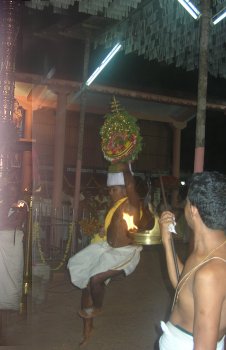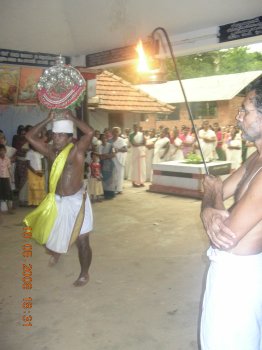
|
 |

|
 |
Thitambu Nritham - Kodoth Rajan e-mail: rajan_kodoth@yahoo.co.in July 13, 2008  Thitambu Nritham is the ritual art form in North Kerala that is more than 700 years old. It is mainly performed by Namboodiris of this part of Kerala. Late Vethiramana Sreedharan Namboodiri is known to be the "Father of Thitambu Nritham." Luckily this ritual art form has not died out with his withdrawal from the stage. Experts in this field like Matamana Sankaran Embranthiri and his disciple Brahmasree Puthumana Govindan Namboodiri are carrying on the great tradition in the north.  The dancer, in the traditional style after performing the usual rituals, comes out of the sanctorum, and standing under the flag, holds aloft the replica weighing about 10kg - 30kg on his head and starts the divine dance. One Namboodiri to bear the thitambu, seven players on percussion instruments, and two persons to carry lamps - in all ten persons are needed to present this. The dance begins with 'Kotti Urayikkal' (drumming to make the dancer possessed). As the dancer comes out carrying the replica of the idol on his head, the Maaraar makes the characteristic drumming when rituals are performed. The word 'Thitambu' suggests the direct manifestation of the deity. This is placed over a decorated turban known as Ushnipeetam. Idols being carried on top of elephants during festivals as also replicas beings held on shoulders while dancing to the rhythm of percussion instruments are a common sight in South and Central Kerala. But, dancing with the replicas on the heads is a unique feature in the North. The origin of Thitambu Nritham cannot be easily traced. Replicas called 'chattam' are made of bamboo or wood within which a beautiful frame with intricate designs is created. Foot work is most important in this dance and this is executed to the rhythm of the drums. Each circumlocution is regulated by a different Thaalam (Thakilati, Atantha, Chempata and Panchari). Thitambu Nritham has undergone some changes in accordance with the trend of the times. Though the basic ones (Thaalavattom) remain the same, there are some changes made in drumming (thaalam). Innovation also adds to the novelty and variety of Thitambu Nritham. |